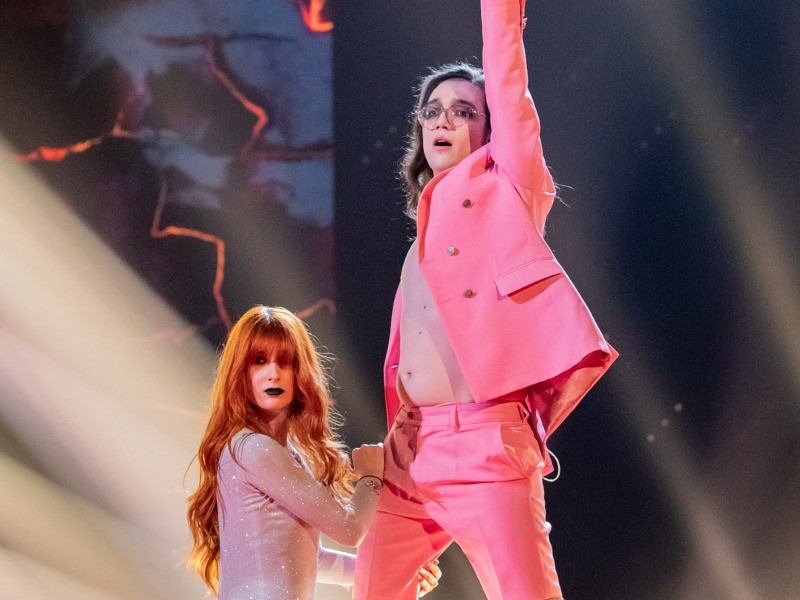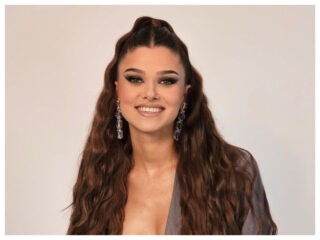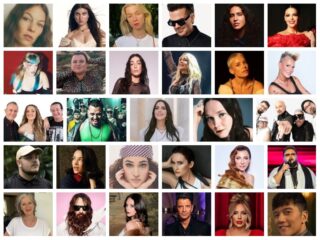We are here to continue our new series: Bold Predictions. We’ll dive into Eurovision countries, recap their highs and lows, and dare to forecast what might be coming next.
The next country on the list is Romania — one of the most anticipated returns for Eurovision 2026, after taking a break from the contest following 2023.
Since their debut in 1993, Romania has brought it all: heartfelt ballads, pop bangers, vampires, round pianos, yodelling, Latin-inspired hits, and multilingual songs. A wild mix of entries that, whether they made you cry or smile, but they never went unnoticed. With Romania, you can never quite predict the next move. What surprises might come next next?
Romania at the Eurovision Song Contest
Eurovision Eras
It’s not easy to divide Romania’s Eurovision journey into clear eras, given the constant shifts in style and genre. Still, some patterns stand out along the way. In the early years of participation, Romania focused on sending well-established names—artists already popular and experienced at the time. That’s why their Eurovision debut featured big names like Dida Drăgan, Dan Bittman, Monica Anghel, and Mălina Olinescu. The first entries all followed a similar formula: ballads performed in Romanian. While these songs showcased strong live performances, they struggled to climb the Eurovision rankings, leading to several breaks in participation.
Dan Manoliu became the head of the Romanian delegation in 2000, marking the start of an experimental phase for Romania in Eurovision. From this point, the country wasn’t afraid to take risks and try new approaches. That same year, Romania sent its first song in English, “The Moon” by Taxi. Compared to previous entries, it showed a small but important improvement—not so much because of the language, but because Romania finally brought something uniquely their own to the stage. The performance featured the traditional instrument, nai (pan flute), traditional costumes, and a fusion of rock with folk elements. In the following years, more songs in English followed, ranging from ballads to pop. Audiences appreciated this versatility, and step by step, Romania began to climb higher in the Eurovision rankings.
What made Romania stand out back then was that they never seemed to follow what other countries were doing. Instead of sending songs that blended in, they took risks of their own. And it paid off— in 2005 Romania reached the podium for the first time, finishing third with Luminița Anghel & Sistem’s “Let Me Try.” Beyond the strong song itself, the staging became iconic: simple yet strikingly original, featuring oil barrels, side cutters, and even a grinding wheel. The following year, Mihai Trăistariu took the stage with “Tornerò,” earning fourth place. Once again, Romania went for effective simplicity—the staging was dynamic without being overdone, giving Mihai the space to showcase his powerful vocals, while the dancers were in charge of keeping the staging dynamic.
Speaking of Romania’s originality, 2007 gave us one of their most playful entries: Todomondo with “Liubi, Liubi, I Love You.” For the first time, Romania went for a song that was lighthearted and fun—though not quite a full “joke entry.” The six members of the group each represented a different nation, turning the performance into a colorful celebration of diversity, with lyrics in six different languages. It was lively, quirky, and instantly memorable—and the audience’s reaction said it all. Another entry that captured the audience’s attention was Elena’s “The Balkan Girls.” Once again, Romania managed to bring color and charm to the stage, blending elements of traditional dance with a song that felt distinctly Romanian yet perfectly in tune with the late 2000s pop sound.
Romania returned to the podium in 2010, this time under delegation head Marina Almăşan, when Paula Seling & Ovi earned another third place with “Playing With Fire.” Although the head of delegation continued to change in the following years, Romania managed to maintain a solid qualification streak. Their formula relied on established artists, powerhouse songs, and staging that wasn’t overly complicated, but always effective. This period brought remarkable variety: the Spanish-Latino bop “Zaleilah” by Mandinga (2012), the dramatic opera song “It’s My Life” by Cezar (2013)—with staging inspired by Romania’s most famous symbol, Dracula—and the return of Paula Seling & Ovi with “Miracle” (2014), a Eurodance anthem enhanced by flawless vocals, a hologram effect, and their now-iconic round piano.
In 2015, Romania took a different approach with Voltaj’s “De la capăt / All Over Again.” Unlike many Eurovision entries with “message songs,” this one felt deeply authentic, rooted in Romania’s own social reality. With lyrics in both Romanian and English, the song spoke about families that were separated due to parents being forced to work abroad. As Romania is among the European countries with the largest diaspora, the message resonated not only at home but across other nations facing the same struggles.
Starting in 2017, under Iuliana Marciuc (for two years) as head of delegation, Eurovision took on a new role in Romania: it became a platform for young, emerging artists. From then on, Romania consistently sent lesser-known artists rather than mainstream names. But was TVR truly prepared for this change? This will be further analysed when speaking about the recent results.
Recent Highs and Lows
In 2017, Romania had a shift towards young, new artists. This shift began with Ilinca and Alex Florea, who competed with “Yodel It.” The gamble seemed to pay off at first—the song felt fresh, and the duo’s unusual mix of yodel and rap fascinated audiences, securing a seventh-place finish. Did they consider that new artists would need more guidance in terms of training and stage presence compared to established performers? The issue wasn’t so much about inexperience—after all, Eurovision can be a great stage for rising talent—but about how these artists were supported and presented. Take “Yodel It” as an example: the staging worked largely because of Ilinca and Alex’s energy and the colourful use of LED screens. Yet, even here, the random presence of two oversized cannons—serving no real purpose—hinted at what was to come: a period marked by uninspired and inconsistent staging.
After the success of “Yodel It,” Romania entered a darker period at Eurovision. The Humans competed with “Goodbye,” the song that broke the country’s qualification streak that had lasted since 1998. While it was a solid rock track with strong vocals, it failed to bring anything new to the contest. The staging, directed by Petre Năstase, relied only on masks and naked mannequins, leaving the performance looking more like a local theatre show than something Eurovision-worthy.
The same issues carried over to Ester Peony’s “On a Sunday.” The song itself wasn’t ground-breaking, but it was far from weak—Ester delivered solid vocals and the track had potential. Yet once again, the staging made her appear “small” amidst a confusing jumble of ideas. With just a chair, two dancers, and a chaotic LED display that tried to do everything—dark gothic vibes, Titanic imagery, fire effects—the performance ended up distracting from both the artist and the song. As a result, Romania failed to qualify yet again.
In 2020, with Liana Stanciu as head of delegation, Romania tried a new approach: selecting a young artist, but this time backed by a major label. A songwriting camp was organised with three rising talents from Global Records, and Roxen was chosen as the representative. During the national selection, she presented five songs, with “Alcohol You” emerging as the winner. An alternative pop ballad with clear Billie Eilish influences—at a time when Eilish was dominating the charts—the song felt modern and promising. Unfortunately, we never got to see its Eurovision journey, as the contest was canceled due to the pandemic.
Roxen returned in 2021 with “Amnesia,” a song tackling mental health struggles. The topic itself was important and relevant, yet the message weighed heavier than the song, which increasingly felt like it was trying to fit into the mold of a “standard Eurovision track.” Staging duties went to Bogdan Păun and Dan Manoliu, but the result was anything but functional for the contest. With inconsistent LED visuals and a performance that leaned more toward experimental theatre than Eurovision spectacle, Roxen’s restless movements weakened the vocal delivery. Once again, Romania missed the final.
In 2022, when Eurovision took place in Turin, the contest faced an unprecedented situation: a stage malfunction that reduced most performances to their bare minimum. Yet, this was the year Romania finally returned to the grand final. With Iuliana Marciuc once again as head of delegation, the country chose WRS (now releasing music under his real name, Andrei Ursu), another Global Records artist. He brought back the fun and energy audiences had once associated with Romania through his English-Spanish Latino track “Llámame.” The staging, designed by Aurel Badea (who had previously worked on Ilinca & Alex Florea’s performance), avoided overcomplication. Even with limited LEDs, the mix of WRS’s charisma and four energetic dancers gave the act a fresh and lively feel. Romania placed 18th in the grand final and the song quickly became a fan favourite within the Eurovision community. Its success cemented Andrei Ursu as a regular presence at Eurovision pre-parties and related events long after the contest.
Romania hit rock bottom in 2023, recording its worst Eurovision result to date. Not only did the country fail to qualify, but it also finished with 0 points in the semifinal—an alarming outcome for a song that was, at least vocally, delivered correctly. This year marked Mihai Predescu’s first time as head of delegation. The national selection crowned Theodor Andrei with “D.G.T. (Off and On).” Importantly, Theodor was not backed by a major music label, unlike the young artists from the previous years.
Several factors contributed to this disastrous outcome. From the start, the song was seen as “not a typical Eurovision track,” but such unconventional entries often surprise positively—especially when performed well. However, Romania stumbled in execution. One crucial part of Eurovision success is promotion: pre-parties and repetition help songs grow on audiences. Instead of building on this, Romania went to the big stage with a completely revamped version of the song, different from what fans had already gotten used to.
Theodor Andrei later revealed in an interview with wiwibloggs that TVR failed to communicate or support him adequately. He stated that the staging was decided without his input, leaving him disappointed and frustrated. And indeed, the staging was incoherent: oversized LED visuals dominated the performance, distracting from the artist, who spent most of the song standing alone on stage. The graphics looked cheap, the concept lacked clarity, and overall it felt more like a misguided experiment than a polished Eurovision act.
The broader issue was clear: TVR seemed to expect young, unestablished artists to simply go along with whatever was decided for them, without providing the necessary guidance, collaboration, or investment. This strategy backfired completely, resulting in Romania’s most painful Eurovision failure.
So what lessons can Romania take from this?
Roadmap: What they should do
A Eurovision songwriting camp took place in Romania this October. More specifically, the Normania Camp will be held in Snagov, with the main goal of creating songs for national selections. Such songwriting camps are common practice—similar events have already been organised in countries like Germany and Malta. The Romanian edition is organized by the Norwegian label The Woods, which has invited TVR to participate.
It’s important to note that hosting a songwriting camp in a country does not automatically mean the resulting songs are destined for that country’s national selection. For example, Ireland’s entry this year, “Laika Party” by Emmy, originated at The Woods’ songwriting camp in Norway. Still, the Normania Camp aims to bring together Romanian, Norwegian, and international composers, topliners, producers, lyricists, and artists for three intensive days of collaboration. Adding to its significance, the event is co-run by Ovi Jacobsen (Romania 2010 & 2014), further strengthening the connection.
When discussing what Romania should do next, there are many issues to address, but one of the biggest problems lies in how artists perceive the contest. The general view of Eurovision within Romania has deteriorated, largely due to poor results in recent years. It’s true that Romania achieved its best results with established artists, but that shouldn’t be the only path forward. With a stronger and fairer selection process, rising talents should also have a chance to shine. The problem is that there is now little interest in Eurovision at all. In the past, the big names in Romanian music felt honoured to represent the country; now, most of them decline the opportunity. And after what happened in 2023 with Theodor Andrei, an independent artist outside the protection of a major label, up-and-coming musicians may think twice before applying as well.
The issues run deeper than just artist choice. The contest’s reputation in Romania has been damaged: many in the public criticise TVR for “spending too much money on a contest that brings no results” (a narrative common in many participating countries). On top of that, TVR’s poor management and lack of communication have led many participants to describe their Eurovision experiences as unpleasant. Finally, a particularly harmful practice has been the broadcaster’s tendency to shift all the blame for bad results onto the artists themselves. This not only damages their image at home but also fuels waves of online hate against them, making Eurovision look less like an opportunity and more like a professional risk.
Back in April, when TVR’s General Director Dan Turturică was asked about Romania’s potential return to Eurovision, his answer was far from hopeful. He stated that the country would only return once the relationship between the national broadcaster and music labels improved. But can that really happen without effort from TVR itself? The statement also highlighted a deeper issue: TVR’s overreliance on artists backed by major labels, in the hope that label involvement will spare the broadcaster both work and criticism. Yet, from the same interview, it became clear that TVR still refuses to assume any responsibility for recent failures. Regarding the 2023 national selection, Turturică emphasised that Theodor Andrei had been chosen “exclusively by the public,” once again shifting the blame onto both the artist and the voters.
He further claimed that TVR “cannot invent singers” and they are “not music composers,” suggesting that the broadcaster’s ability to influence the quality of songs in Selecția Națională is very limited. But rather than an honest acknowledgment of challenges, this comes across as another attempt to appear guilt-free. It also raises an uncomfortable question: do TVR’s leaders truly understand their role as a national broadcaster—and with such a mindset, how do they expect to attract stronger collaborations in the future?
Selecția Națională, Romania’s national selection, has infuriated Eurovision fans more than once. Unlike in many other countries, the event in Romania feels almost mythical—fans rarely have access to it. The only way to get in is through a so-called Facebook comments lottery (yes, really), which often leaves people questioning its fairness. The selection itself usually takes place in a small studio with a small stage, but the bigger issue is the lack of professionalism. Instead of looking like a well-rehearsed, coherent show, it often feels more like “bring your own props and let’s see what happens.”
What TVR desperately needs is a selection process run by people who actually follow Eurovision and understand what the contest has become—people able to choose songs that are both suitable and original. No more jury members dismissing entries just because they aren’t in English, and no more outdated comparisons to Loreen’s “Euphoria” as the sole definition of a “Eurovision song.” Times have changed, music styles at Eurovision have evolved, yet Romania seems stuck in the early 2010s, still chasing the ghost of generic English-language pop hits.
For Romania to return powerfully to Eurovision, they need to bring back the fun they once had. This doesn’t necessarily mean sending a joke entry, but rather something original, enjoyable, and memorable—an act that leaves an impression. Moldova is a perfect example of how this can be done: their entries often feel both authentic and entertaining, rooted in their national sound yet perfectly adapted to the Eurovision stage. From Zdob & Zdub with the Advahov Brothers, to SunStroke Project, or DoReDos, they’ve shown how much identity, energy, and clever staging can elevate a song.
Romania actually has the right ingredients in its own music scene. The charts today are full of modern songs rooted in traditional sounds that could thrive at Eurovision. Artists like Theo Rose, F.Charm, or Irina Rimes (although from Moldova, she promotes mostly in Romania) already have that blend of modernity and cultural flavour that the contest celebrates. But for any of these names—or rising talents with similar qualities—to succeed, TVR must change its approach.
First, the national selection process should be treated as seriously as the Eurovision participation itself. By the time a winner is chosen, you should already have a strong product to refine, not a blank slate to start from scratch. Second, promotion is key. Pre-parties across Europe, official music videos, and artist interaction with fans abroad are not optional extras—they are essential. Finally, and perhaps most importantly, TVR and the artists must work together as partners. While no broadcaster can “invent” an artist, once they take on the responsibility of bringing a song to Eurovision, it becomes their duty to collaborate on every detail—big or small—that makes a performance Eurovision-worthy.
Time for some Bold Predictions
Here’s what I predict for Romania’s Eurovision future:
- A returning artist from Romania’s Eurovision history
It wouldn’t be a surprise if a familiar face makes a comeback. MIHAI has tried several times, but Ovi and Ilinca have also openly expressed interest and they would be welcomed with enthusiasm as they remained connected with the Eurovision community. - A big-name artist finally says yes
For years, Romanian stars avoided Eurovision, but there are hints of change. Theo Rose, an established name in Romania, previously stated she doesn’t exclude Eurovision. - The boldest prediction: a Top 10 comeback
While predicting a win may be premature given the current state of affairs, Romania has the potential to break back into the Top 10 with the right formula. A song blending traditional Romanian sounds with pop or electronic production could stand out, especially if paired with a strong stage concept.
Now it’s your turn! What has been your favourite Romanian moment at Eurovision so far? And while you’re at it, make your own bold prediction: Who do you think will represent Romania next, and could they finally bring home that long-awaited win?











Mihai please
would love for them to send Cezar again tbh
They just have to start choosing right again. At Selectia there was always a better entry in the later years of unsuccessful participation.
Romania has its work cut out for them. Yes, it’s great that they are returning, but I think the first goal is to try to get to the final again. Let’s see if they have changed their ways.
D.G.T. was a masterpiece, robbed of a good staging. And “DGT’ed” should become a verb for when a country’s delegation refuses to support their artists, or forces a different staging / song version on them.
Masterpiece my ass, it was a NQ from the start. Just because the singer didn’t get propper treatment doesn’t mean that he would have been anywhere near perfect.